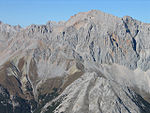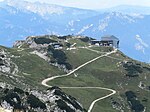Hinterreintalschrofen
Mountains of BavariaMountains of Tyrol (state)Mountains of the AlpsTwo-thousanders of AustriaTwo-thousanders of Germany

The Hinterreintalschrofen is a 2,669 m high peak on the main, east-west oriented crest (the Teufelsgrat or "Devil's Ridge") of the Wetterstein Mountains in the Eastern Alps. It is a massive and dominant mountain with a high rock face that plunges into the Reintal valley to the north and stamps the appearance of the Wetterstein when seen from the north. In spite of that, the mountain is rarely climbed. Its neighbouring peaks are the Hochwanner (2,746 m) to the west and the Hundstallköpfe (2,533 m) to the east. The Teufelsgrat runs along the national border between the Austrian state of Tyrol, (Gaistal) in the south and the German state of Bavaria, (Reintal) in the north.
Excerpt from the Wikipedia article Hinterreintalschrofen (License: CC BY-SA 3.0, Authors, Images).Hinterreintalschrofen
Südwandsteig,
Geographical coordinates (GPS) Address Nearby Places Show on map
Geographical coordinates (GPS)
| Latitude | Longitude |
|---|---|
| N 47.39611 ° | E 11.07583 ° |
Address
Südwandsteig
Südwandsteig
6105
Tyrol, Austria
Open on Google Maps











